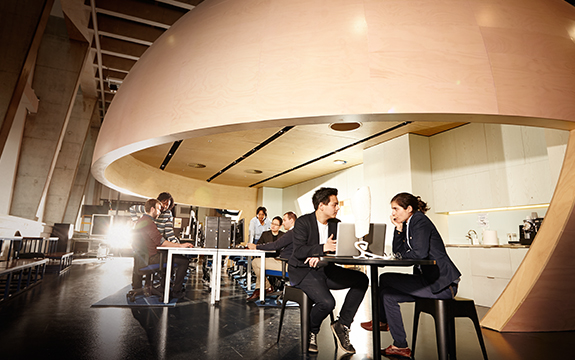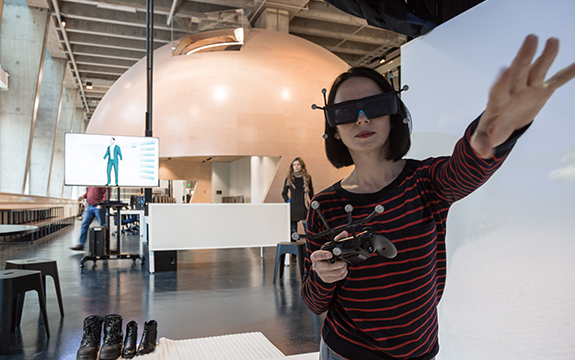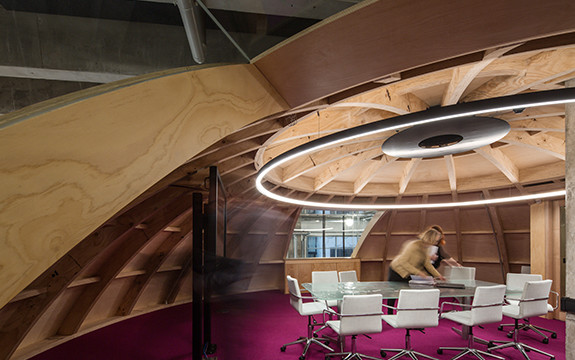Factory of the Future: taking the lead in design and manufacturing

In Summary
- A space that takes ideas from concept to reality
- Located in a $100 million complex at Swinburne's Hawthorn campus
- This article originally appeared in Swinburne's Venture magazine
Could a product invention be conceived, tested and ready for manufacture in a single day?
'Absolutely,' says Swinburne University of Technology’s Professor Geoff Brooks, Pro Vice-Chancellor of Future Manufacturing, speaking inside a giant timber dome on the university’s Hawthorn campus, where it feels as though anything is possible.
The Advanced Manufacturing and Design Centre, known as Swinburne’s Factory of the Future, is a dedicated space for research and teaching in manufacturing and design-led innovation.
Opened in July, the $100 million complex features a superior suite of advanced manufacturing equipment – including visualisation tools, computer-aided design, functional prototyping and rapid fabricating equipment.
'The factory’s whole concept is that you walk in with an idea and by the end of the day it could be built and tested. It creates a seamless transition from concept to product,' Professor Brooks says.
Studio city
There are five studios in the complex, comprising a combination of technologies that make rapid development from concept to product possible.
There’s a 3D Visualisation and Design Studio, in which new products can be rapidly developed using digital visualisation equipment; a Rapid Manufacturing Studio with machines able to convert digital concepts to metal, plastic or ceramic prototypes; and an Advanced Inspection Studio in which prototypes can be tested for surface quality and internal defects using a laser ultrasound machine.
Then there’s the Biodevice Innovation Studio, which has specialised equipment for producing new medical devices, combining electronics, optics, chemistry and biomaterials-handling with rapid prototyping and the Design for Resource Efficiency Studio, capable of assessing the sustainability and the possibilities of recycling for prototypes.
Professor Brooks says it’s this translation of specialist knowledge to specialist products that will provide the future of Australian manufacturing with robust possibilities for decades to come.
'The Factory of the Future will help industry develop products that are complex or niche with high value. At Swinburne we are celebrating clever design manufacturing and creating a positive vibe with making, designing and building things in the community,' he says.

A positive step
The Factory of the Future’s 3D Visualisation and Design Studio could change the manufacture of prosthetic feet, thanks to a Bachelor of Design in industrial design honours-year research project by Jonathan Yap. Mr Yap and his supervisor, Dr Gianni Renda, created a low-cost 3D-printable prosthetic foot that has the potential to redefine how prosthetics are made available to people in developing countries.
The world-first design can be modified and produced onsite, and on demand. Better yet, its wholesale cost is only about $15.
The design demonstrates the capability of 3D printing in rapid prototype development and batch production – a key feature of the 3D Visualisation and Design Studio. Equipment in the Factory of the Future would also enable the prototype to be further developed.
On the front line
Professor Bronwyn Fox joined the Factory of the Future as its inaugural director this year. She came to Swinburne from Deakin University, where she was research director of the Carbon Nexus facility.
Professor Fox believes Swinburne is poised to play a leading role in the global challenge to integrate the design, automation and control of manufacturing systems. 'The vision to develop the Factory of the Future into a vibrant showcase for innovative manufacturing is absolutely inspiring.'
Innovative solutions to wicked problems
Ten Swinburne PhD students and two postdoctoral researchers are joining forces to develop the next generation of innovative and profitable medical devices.
As part of the world-first BioReactor PhD program, the students have identified 100 opportunities for the medical device industry to solve problems in hospitals, care homes and other health-care environments.
'We have thrown them in the deep end of the valley of death – a space where university research is translated into solutions to real-world problems,' says the director of Swinburne’s ARC Training Centre in Biodevices, Professor Paul Stoddart.
'The challenge for our students is to work with our industry partners to identify innovative solutions to wicked problems. Wicked problems cannot be solved by the application of known methods; they demand creative solutions, and this is the strength of the BioReactor PhD program.'
The students will present their best ideas to medical device companies, which will choose the project and student they would like to work with. The program is backed by $1.8 million in funding from the Australian Research Council.
The intention of the centre is, like the Factory of the Future, to take ideas from concept to reality, Professor Stoddart says.
'We are changing what it means to undertake research in Australia through helping researchers to gain appropriate skills while building relationships with industry,' he says.
'Australia has a vibrant medical technology industry with revenues of over $10 billion per annum, and we want to build on that.'


